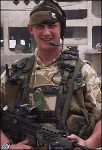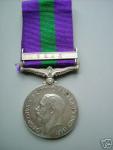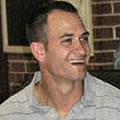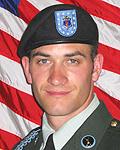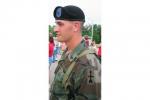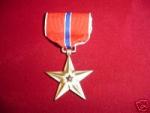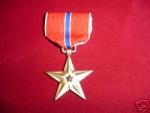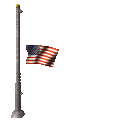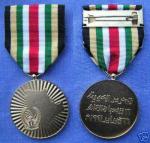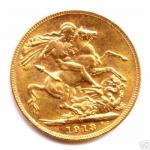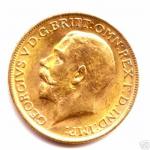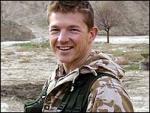-
Posts
3,575 -
Joined
-
Last visited
-
Days Won
27
Content Type
Profiles
Forums
Blogs
Gallery
Events
Store
Everything posted by bigjarofwasps
-
Distinguished Service Cross a. The Distinguished Service Cross, section 3742, title 10, United States Code (10 USC 3742), was established by Act of Congress 9 July 1918 (amended by act of 25 July 1963). b. The Distinguished Service Cross is awarded to a person who while serving in any capacity with the Army, distinguished himself or herself by extraordinary heroism not justifying the award of a Medal of Honor; while engaged in an action against an enemy of the United States; while engaged in military operations involving conflict with an opposing or foreign force; or while serving with friendly foreign forces engaged in an armed conflict against an opposing Armed Force in which the United States is not a belligerent party. The act or acts of heroism must have been so notable and have involved risk of life so extraordinary as to set the individual apart from his or her comrades.
-
The Medal of Honor -------------------------------------------------------------------------------- The Medal of Honor is the highest medal awarded by the United States. It has only been awarded 3,428 times in the nation's history. Below is an excerpt of the Army regulation that describes the eligibility criteria for award of the Medal of Honor... a. The Medal of Honor [Army], section 3741, title 10, United States Code (10 USC 3741), was established by Joint Resolution of Congress, 12 July 1862 (amended by acts 9 July 1918 and 25 July 1963). b. The Medal of Honor is awarded by the President in the name of Congress to a person who, while a member of the Army, distinguishes himself or herself conspicuously by gallantry and intrepidity at the risk of his life or her life above and beyond the call of duty while engaged in an action against an enemy of the United States; while engaged in military operations involving conflict with an opposing foreign force; or while serving with friendly foreign forces engaged in an armed conflict against an opposing armed force in which the United States is not a belligerent party. The deed performed must have been one of personal bravery or self-sacrifice so conspicuous as to clearly distinguish the individual above his comrades and must have involved risk of life. Incontestable proof of the performance of the service will be exacted and each recommendation for the award of this decoration will be considered on the standard of extraordinary merit.
-

Op Telic Casualties & Fatalities
bigjarofwasps replied to bigjarofwasps's topic in Modern Campaigns and Conflicts
UK soldier killed in Basra named Chris Hickey was described as the "epitome of a professional soldier" A British soldier killed by a roadside bomb in Basra on Tuesday has been named by the Ministry of Defence. Sergeant Christian Ian Hickey, 30, of the 1st Battalion The Coldstream Guards, died from his injuries. The married soldier from Bradford, West Yorkshire, was on a routine patrol in the southern Iraqi city when the attack happened. His death brings the number of British troops killed in Iraq to 97 - 64 of them as a result of hostile activity. The Commanding Officer of the 1st Battalion Coldstream Guards Battle Group, Lieutenant Colonel Nick Henderson, said Sgt Hickey had moved forward on foot to reconnoitre a route for the patrol when he was hit by the blast. He said it was typical of Sgt Hickey that he had been leading from the front when he was killed, and praised him as the "epitome of a professional soldier". UK Prime Minister Tony Blair sent his condolences to the soldier's family during Commons questions on Wednesday. Major Steven Melbourne, based in Basra, said: "A British soldier died from the injuries sustained from a roadside blast at 11.23pm local time last night. The incident is under investigation." The explosion happened on the eve of the start of former leader Saddam Hussein's trial. In another attack, a US soldier was killed by a roadside bomb while on patrol near Iskandariyah, 50km (30 miles) south of Baghdad. -

Op Telic Casualties & Fatalities
bigjarofwasps replied to bigjarofwasps's topic in Modern Campaigns and Conflicts
UK soldier killed by Basra bomb 97 UK soldiers have died in Iraq since military action began A British soldier has been killed by a roadside bomb in Basra, the Ministry of Defence has confirmed. The soldier was on a routine patrol in the southern Iraqi city and died as a result of his injuries at about 2323 local time on Tuesday (2123 BST). He will not be named until his next of kin have been informed of his death, the MoD said. The death brings the number of British troops killed in Iraq to 97 - 64 of them as a result of hostile activity. Major Steven Melbourne, based in Basra, said: "A British soldier died from the injuries sustained from a roadside blast at 11.23 local time last night. "The incident is under investigation." The explosion happened on the eve of the start of former leader Saddam Hussein's trial. In another attack, a US soldier was killed by a roadside bomb while on patrol near Iskandariyah, 50km (30 miles) south of Baghdad. -

Op Telic Casualties & Fatalities
bigjarofwasps replied to bigjarofwasps's topic in Modern Campaigns and Conflicts
Death of a British Officer in Iraq - Captain Ken Masters Published Sunday 16th October 2005 It is with deep regret that the Ministry of Defence can confirm that the body of Captain Ken Masters was discovered in his accommodation in Waterloo Lines, Basra, Iraq on Saturday 15 October 2005. Captain Masters was Officer Commanding 61 Section, Special Investigation Branch, Royal Military Police. He had been responsible for the investigation of all in-theatre serious incidents plus investigations conducted by the General Police Duties element of the Theatre Investigation Group. Ken Masters was aged 40, married with two children and had served with the Royal Military Police since 1981. He was commissioned from the ranks in 2001 and served most of his career with the Special Investigation Branch. The Ministry of Defence asks the media to respect the privacy of Captain Master's family at this time. -

Medals for service in Iraq
bigjarofwasps replied to mariner's topic in Modern Campaigns and Conflicts
-
Cheers Guys, for all your replies. The US medals system is very complicated isn`t it. But thanks for taking the time to explain it all to me. G.
-

Op Telic Casualties & Fatalities
bigjarofwasps replied to bigjarofwasps's topic in Modern Campaigns and Conflicts
Spc. Michael J. Wendling, 20, of Mayville, Wis. Wednesday, September 28 2005 @ 08:13 AM EST Contributed by: tomw Milwaukee Journal Sentinel -- The news passed through the stands Monday evening at the Mayville High School JV football game - Michael Wendling, who played on the football, basketball and golf teams and joined the military while still a student, had been killed in Iraq. Among the words murmured by stunned people as the football game unfolded before them: explosion, Iraq, Humvee, Mayville. "In typical small-town fashion, it had drifted through the town," said Mayville High School Principal Lee Zarnott. "Unfortunately, bad news travels fast." Wendling, 20, a specialist, was killed Monday with Sgt. Andrew P. Wallace, 25, of Oshkosh when a roadside bomb exploded as they drove past it in Iraq. They were members of Fond du Lac-based Charlie Company of the Wisconsin National Guard 2nd Battalion, 127th Infantry Regiment. Their deaths bring to 47 the number of Wisconsin service members killed in Iraq since March 2003. A high school friend of Wendling's, Spc. Jeremy Roskopf of Brownsville, suffered shrapnel wounds to his legs. Roskopf and Wendling signed up for the National Guard together while they were in high school. They played on the Mayville golf team, which won the conference championship their senior year. Wendling, who was on the dean's list at the University of Wisconsin-Milwaukee when his unit was activated, frequently kept in touch with his family via e-mail and talked about what it was like to drive the large, heavy Humvees in Kuwait and Iraq, said his father, Randy Wendling. "He said they don't go very fast, but he seemed pretty excited about what he was doing," Randy Wendling said in a phone interview Tuesday. The Appleton-based 2nd Battalion, 127th Infantry Regiment was activated in June and trained at Camp Shelby, Miss. The unit moved to Kuwait in mid-August and has been based in northern Kuwait, providing security to convoys traveling from Kuwait into Iraq, said Wisconsin National Guard Lt. Col. Tim Donovan. Wendling's father said the roadside bomb hit his son's Humvee near Basra, in southern Iraq. Wendling was the driver, Roskopf was the gunner who stands in the middle of the vehicle and Wallace was the team leader, who normally sits in the front passenger seat. Randy Wendling said he saw his son shortly before the unit deployed overseas last month. He spent his home leave going to Brewers games, visiting with family and friends and golfing. His son was upbeat in his e-mails and enjoyed serving in the Wisconsin National Guard, the elder Wendling said. "He talked about where they were based and what it was like, what they were going to be doing, how hot it was there," said Randy Wendling. In his last e-mail, received a couple of days before he died, Wendling asked about a care package his family sent him that included bedsheets and beef jerky and told his folks that his company was very busy. Stu Strook coached Wendling in junior varsity football and golf and remembered a guy who wasn't the most talented athlete but someone who worked hard to improve himself. It was common to see Wendling hitting buckets of golf balls, even after matches, until dark. "I would call him a grinder. He worked hard. He had a good heart," said Strook. Wendling also liked to eat. He wasn't fat, so sometimes his teammates wondered where he put all the food. Strook recalled returning from a golf match one day when the team stopped at Burger King. Wendling ordered a Whopper Value Meal with fries and a drink. Nothing unusual about that, except that Wendling went back for four more Whoppers - quarter-pound burgers - and ate them all, to the astonishment of everyone watching him, Strook said. "Mike was a personality, I guess you would say. He had a great sense of humor. He was a kid who liked to have fun, and kids liked to be around Mike because he was so much fun," said Strook. Wendling had not declared a major at UWM, but his father said he was leaning toward getting a degree in the sciences. His high school marketing teacher, Rod McSorley, said he thought Wendling would have become an engineer. A couple of dozen marketing students from Mayville organized a trip to New York their senior year. The group took in the sights, visited Madison Square Garden and saw "The Lion King" on Broadway. A photo of the group taken on the Staten Island Ferry is pinned to a bulletin board in McSorley's office. McSorley said he was looking at the picture of Wendling and his classmates mugging for the camera as he talked to a reporter Tuesday about his former student. "When we visited New York, we visited ground zero, and that was important to him. He was close enough to 9-11 to embrace its importance," said McSorley. "He had very good family values. That wouldn't surprise me (that) he had the feeling of giving back." http://www.legacy.com/PE/Soldiers.asp?Page...rsonID=15240017 -

Op Telic Casualties & Fatalities
bigjarofwasps replied to bigjarofwasps's topic in Modern Campaigns and Conflicts
Sgt. Andrew P. Wallace, 25, of Oshkosh, Wis. Wednesday, September 28 2005 @ 08:17 AM EST Contributed by: tomw Oshkosh Northwestern -- An Oshkosh soldier killed in Operation Iraqi Freedom is being remembered for his love of family and country and for his dedication as a teacher and wrestling coach. Sgt. Andrew Wallace, 25, was killed by a roadside bomb, while he helped escort a convoy of supply trucks in Iraq, his father, Pete Wallace, said Tuesday. Wallace said his son joined the Army National Guard in part to help pay for college costs, but he also had a deep and lasting patriotism for his country. “He was proud to serve his country and he knew the risks that came with it,” said Wallace, who lives in the Dodge County community of Fox Lake. “Everything he did, he did with enthusiasm. He enjoyed sports with enthusiasm and he loved his country with enthusiasm.” He said his son was in good spirits when he last talked to him via cell phone about a week ago. “He called me at work,” Wallace said. “He preferred being out on the missions instead of being back in the base.” Wallace served with the Wisconsin Army National Guard 2nd Battalion, 127th Infantry Regiment based in Appleton. Also killed by the roadside bomb in Shaibah, Iraq, was Spc. Michael Wendling, 20, of Mayville, who was driving the Humvee that he, Wallace and another soldier were riding in near Basra at the time of the explosion, Wendling’s father, Randy Wendling, said Tuesday. Wallace was the team leader who normally sits in the front passenger seat. The third soldier, who was injured, served as a gunner. Major Gen. Albert H. Wilkening of the Wisconsin National Guard said he has ordered flags of all Wisconsin National Guard armories, air bases and other facilities lowered to half-staff in memory of Wallace and Wendling. Wallace, a physical education teacher since 2003 who taught at Oshkosh North High School and Emmeline Cook Elementary School, was deployed to Kuwait and Iraq in June. His father said Wallace was a member of the National Guard for about six years. Pete Wallace recalled the last time he saw his son, which was June 9 for a sendoff at Volk Field at Camp Douglas in western Wisconsin. He said family members gave him hugs, plenty of love and told him to stay safe before he departed. “He wanted to come home as a veteran,” Wallace said. Wallace’s father said funeral arrangements are pending. Overall, 46 Wisconsin military members have died during the war in Iraq and so have more than 1,900 U.S. troops nationwide. Local soldiers who died include Pfc. Brent Vroman of Omro, who was a member of the U.S. Marine Corps Reserve and Army Reserve Capt. Benjamin Jansky of Oshkosh. Wallace’s death was a shock to those who knew him, including wrestlers at North, where he was an assistant wrestling coach. “He was there for us all of the time and whenever we had a problem we could go to him. He was easy going and fun to be around,” said senior Nick Wolff, a member of the North wrestling team. “He taught us to respect everybody no matter what happened to us.” Wallace was a 1998 graduate of Ripon High School where he played football, baseball and wrestled. His father said Wallace also was a WIAA football official and had been an avid fan of the Green Bay Packers. Lucas Seelow, a senior at North and a member of the wrestling team, said Wallace put a smile on the faces of wrestlers. “He liked the sport and enjoyed being out there with us,” Seelow said. “He was at school at 6:30 each morning to help anyone who wanted to lift weights and to give his support.” Gary Westerman, former head wrestling coach at North, said Wallace’s enthusiasm was contagious. “Andrew was the ultimate kid at heart. He was never in a bad mood and always smiling and had positive things to say,” said Westerman, who is a physical education teacher at a Kimberly Middle School. “He was an all-around great guy and a great friend.” Westerman said Wallace was proud to be in the military and often talked about it. He said Wallace and his wife had just purchased a house in Oshkosh. “He was real excited about that,” Westerman said. “He couldn’t wait to have me over.” Phil Marshall, principal at Emmeline Cook, said Wallace kept in contact with school staff via a Web site. “He would take pictures of all the missions he was on and would post them on the Web site so we could get a look at what was going on,” Marshall said. “He sent e-mails to staff updating what was happening in Iraq. It was really a comfort to us to have contact with him on a regular basis.” Marshall said Wallace was an extraordinary person. “He made an impact on everyone in school from students to staff and parents,” Marshall said. “He always had a smile on his face and a positive attitude. The lack of that energy has left a big hole here.” http://www.legacy.com/AZCENTRAL/Soldiers.a...rsonID=15235097 -
Many thanks for all your replies. Can anyone tell me about what medals this unit are awarded for service in Iraq? 2nd Battalion, 127th Infantry Regiment, 32nd Infantry Brigade
-
Hi, Can anyone tell me, which medals the National Guard are issued for the current Iraq conflict? I`ve been told that they get the National Defence Medal, when they join up. Possibley the War on Global Terror Medal (exp) & and possibley the Iraq campaign medal, for service in Iraq, can anyone confirm this for me. Finally, if a National Guardsman, was to be killed in action he`d be entitled to the Purple Heart. I assume that the National guard is the US counterpart of the Britsh TA? Gordon.
-

British Serviceman awarded Bronze Star
bigjarofwasps replied to bigjarofwasps's topic in United States of America
Cheers guys, that is very interesting. Could you explain the "V", device you mentioned is this worn on the ribbon? Do you get letters after yuor name if you win a Broze or Silver Star? -
Lovely piece whatever it is?
-

History of the Gold Sovereign
bigjarofwasps replied to bigjarofwasps's topic in Coins & Commemorative Medallions
Yes its lovely isn`t it, the attention to detail, in these sovereigns is remarkable. This one of the reaons why, its such a pleasure to collect them!!!!!! -

British Serviceman awarded Bronze Star
bigjarofwasps replied to bigjarofwasps's topic in United States of America
Cheers Dave, I think that just about answers my question, thank you very much!!!! But, how long does all that take & can you define meritous service for me? Who would put a foreign soldier forward for say a Bronze Star, would it be the commander on the ground? MrBean, you also posed an interesting question, given what Dave, says, your point seems to hint, that they are given out like sweets? How do you tell the difference between a BS, that has been awarded for bravery in battle, and one for meritous service, I`m confused? -
What about the other awards such as the Bronze & Silver Star, whats the criteria for those? How is it that during the current conflict in Iraq, a vast number of British serviceman have come to be awarded American medals? Bronze Star Medal Major Adam Timothy Stephen CRAWFORD Royal Marines Lieutenant Colonel Jani MAROK Royal Marines Major Simon James BANTON The Staffordshire Regiment Corporal Thomas Edward BOND Royal Tank Regiment Major General John COOPER DSO MBE Late The King?s Own Scottish Borderers Lieutenant Colonel Neil Davidson FRASER Royal Corps of Signals Lieutenant Colonel Mark Andre HOLDEN The Worcestershire and Sherwood Foresters Colonel Paul Richard Lorimer LANE Late Royal Regiment of Artillery Warrant Officer Class 2 Lee James MASON Royal Corps of Signals Major John Stuart McDONALD The Parachute Regiment Major John Christopher PEREZ MBE Royal Gibraltar Regiment Major Michael William SHERVINGTON The Parachute Regiment Colonel Mark Evan WARING OBE Late Royal Regiment of Artillery Captain Colin WHITWORTH The Royal Logistic Corps Lieutenant Colonel Peter Simon Paton WORSLEY Royal Regiment of Artillery Major John Charles Julian WRIGHT The Royal Anglian Regiment Who decides, who and for what these medals are awarded? I assume for such cases, that result in the death of America troops, that this type of thing would go unrewarded, as it draws attention to the fact that American soldiers are being killed, am I right? Are these awards given out as good will awards, to the likes of Liason Officers, etc? Or do you have to do something of genuine note? Are they given out like sweets? I feel that to a certain exstent, not to be little the British awards, but these seem to be given out more regularly than is true of 10 to 15 years ago. Especially in view of the current conflict in Iraq, which is is very unpopular in the UK as well as the US.
-
Theres a few for sale on the Liverpool Medal companys website, about ?595 each, if I remember correctly?
-
Hi, Can anyone tell me how a British serviceman, comes to be awarded an American gong? Bronze Star Medal Major Adam Timothy Stephen CRAWFORD Royal Marines Lieutenant Colonel Jani MAROK Royal Marines Major Simon James BANTON The Staffordshire Regiment Corporal Thomas Edward BOND Royal Tank Regiment Major General John COOPER DSO MBE Late The King?s Own Scottish Borderers Lieutenant Colonel Neil Davidson FRASER Royal Corps of Signals Lieutenant Colonel Mark Andre HOLDEN The Worcestershire and Sherwood Foresters Colonel Paul Richard Lorimer LANE Late Royal Regiment of Artillery Warrant Officer Class 2 Lee James MASON Royal Corps of Signals Major John Stuart McDONALD The Parachute Regiment Major John Christopher PEREZ MBE Royal Gibraltar Regiment Major Michael William SHERVINGTON The Parachute Regiment Colonel Mark Evan WARING OBE Late Royal Regiment of Artillery Captain Colin WHITWORTH The Royal Logistic Corps Lieutenant Colonel Peter Simon Paton WORSLEY Royal Regiment of Artillery Major John Charles Julian WRIGHT The Royal Anglian Regiment
-

Op Telic Casualties & Fatalities
bigjarofwasps replied to bigjarofwasps's topic in Modern Campaigns and Conflicts
The Department of Defense announced today the death of two soldiers who were supporting Operation Iraqi Freedom. They died in Shaibah, Iraq, on Sept. 26, when an improvised explosive device detonated near their HMMWV during convoy operations. They were also attacked by enemy forces using small arms fire. Both soldiers were assigned to the Army National Guard's 2nd Battalion, 127th Infantry Regiment, 32nd Infantry Brigade, Fond du Lac, Wis. Killed were: Sgt. Andrew P. Wallace, 25, of Oshkosh, Wis. Spc. Michael J. Wendling, 20, of Mayville, Wis. -

Medals for service in Iraq
bigjarofwasps replied to mariner's topic in Modern Campaigns and Conflicts
-

Some things I brought back from Iraq
bigjarofwasps replied to Paul R's topic in Modern Campaigns and Conflicts
The British Army frowns, on the bringing back of war trophies, stating that they are property of the Iraqi people. I assume that the American Coast Guard, takes a different view of this thinking. I`d very much like to hear other peoples opinions of this this. -

History of the Gold Sovereign
bigjarofwasps replied to bigjarofwasps's topic in Coins & Commemorative Medallions
Found these pics on the net, thought someone might find them useful. Right beauties, you can really see the detail!!!! -

Op Telic Casualties & Fatalities
bigjarofwasps replied to bigjarofwasps's topic in Modern Campaigns and Conflicts
MoD names soldier killed in Iraq Major Bacon, known as Matt, is the 95th UK soldier to die in Iraq A British soldier killed in an attack in the southern Iraqi city of Basra on Sunday has been named by UK officials. The Ministry of Defence said Major Matthew Bacon, who was 34 and from the London area, died when a roadside bomb hit the vehicle he was travelling in. Major Bacon's parents said he was a hero whom they believed invincible and that he had served in many conflict zones around the world. Three other soldiers badly hurt in the blast are now out of danger. We would be very grateful to everyone if our family and friends could be left in peace to come to terms with our very sad loss Major Bacon's family statement The MoD said that they were still being treated at a field hospital in Britain's Shaibah base. Major Bacon's family said in a statement: "We have always understood the risks attached to Matthew's career but never imagined that anything could or would happen to our son. "We are immensely proud of Matthew, of the leader he became, the lives of people he touched directly and indirectly and the good work he did throughout his career. "We would be very grateful to everyone if our family and friends could be left in peace to come to terms with our very sad loss." Improvised device Major Bacon's death brings the number of UK soldiers killed in Iraq to 95. In a statement, the MoD said the fatal attack took place at approximately 11.00 (0815 BST) on Sunday when an armoured Snatch Landrover was attacked with an improvised device. "Our thoughts and prayers are with the family at this difficult time," it said. An Iraqi civilian was also injured in the attack and was taken to an Iraqi hospital for treatment. As always, my thoughts are with the family, and the families of those injured, in this appalling act of violence John Reid Defence Secretary Speaking from Kosovo on Sunday, where he is visiting British troops, Defence Secretary John Reid sent his condolences. He said: "I was greatly saddened to hear this morning of the death of a British soldier on duty in Iraq. "As always, my thoughts are with the family, and the families of those injured, in this appalling act of violence." The Shaibah base, about 10 miles south-west of Basra, is the British logistics headquarters in Iraq. On 5 September two British soldiers were also killed by a roadside bomb as they travelled in a convoy five miles east of the base. -
I wouldn`t like to say, but its obviously been privatey made. So its anyone ones guess I suppose. Looks nice though doesn`t it?
-

Op Telic Casualties & Fatalities
bigjarofwasps replied to bigjarofwasps's topic in Modern Campaigns and Conflicts
UK soldier dies in southern Iraq Sunday 11th September 2005 The injured soldiers are being treated at a field hospital One British soldier has been killed and three others injured in an attack in Iraq's Basra province, the Ministry of Defence has confirmed. A spokesman in Basra, southern Iraq, told the BBC the casualties were being treated at Britain's Shaibah base. A BBC correspondent in Baghdad said a roadside bomb had been detonated as the soldiers' convoy passed. The MoD said an investigation was ongoing. The death brings the number of UK soldiers killed in Iraq to 95. In a statement, the MoD said the fatal attack took place at approximately 11.15 (0815 BST). As always, my thoughts are with the family, and the families of those injured, in this appalling act of violence John Reid Defence Secretary "Our thoughts and prayers are with the family at this difficult time," it said. Speaking from Kosovo, where he is visiting British troops, Defence Secretary John Reid sent his condolences. He said: "I was greatly saddened to hear this morning of the death of a British soldier on duty in Iraq. "As always, my thoughts are with the family, and the families of those injured, in this appalling act of violence." The Shaibah base, about 10 miles south-west of Basra, is the British logistics headquarters in Iraq. On 5 September two British soldiers were also killed by a roadside bomb as they travelled in a convoy five miles east of the base.




